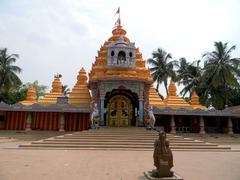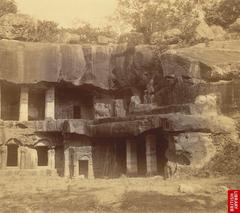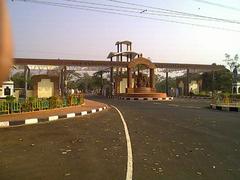Bhringesvara Siva Temple: Visiting Hours, Tickets, and Bhubaneswar Historical Sites Guide
Date: 04/07/2025
Introduction
The Bhringesvara Siva Temple, located in the heart of Bhubaneswar—India’s Temple City—is a remarkable yet often overlooked treasure of Odisha’s spiritual and architectural legacy. Dedicated to Lord Shiva and named after the sage Bhringi, the temple stands as a living testament to centuries of devotion, artistry, and dynastic change. Built during the transitional period between the Somavamsi and Ganga dynasties (late 13th–early 14th century CE), it showcases the mature Kalinga architectural style, celebrated for its elegant curvilinear spires and intricate stone carvings.
Beyond its architectural allure, the Bhringesvara Siva Temple remains an active center for Shaivite worship. Daily rituals, vibrant festivals like Maha Shivaratri, and community ceremonies continue to animate the temple, preserving Odisha’s intangible cultural traditions. This guide provides comprehensive information: historical context, architectural highlights, location and access, visiting hours, ticketing, travel tips, and conservation insights. Whether you are a history enthusiast, spiritual seeker, or cultural traveler, this resource will equip you to explore the Bhringesvara Siva Temple with depth and respect.
For further exploration, consult reputable resources such as Outlook Traveller, TravelSetu, and the official Odisha Tourism website.
Contents
- Introduction
- Historical Background
- Architectural Features and Symbolism
- Location and Accessibility
- Visiting Hours and Ticket Information
- Sustainable Travel & Visitor Etiquette
- Facilities and Accessibility
- Conservation Challenges
- Tips for Visitors
- Nearby Attractions
- Frequently Asked Questions (FAQ)
- Conclusion and Recommendations
- Sources and Further Reading
Historical Background
Origins and Early History
The Bhringesvara Siva Temple is a significant marker in Bhubaneswar’s rich temple landscape. It was constructed during a pivotal era, bridging the Somavamsi and Ganga dynasties when the Kalinga architectural tradition reached maturity. The temple’s dedication to Lord Shiva—and its association with the sage Bhringi—enriches its mythological and spiritual resonance. The legend of Bhringi, a devoted follower of Shiva, adds depth to the temple’s narrative and its enduring role as a site of Shaivite worship.
Historical Context within Bhubaneswar
While overshadowed in scale by the monumental Lingaraja, Mukteswara, and Rajarani temples (Outlook Traveller), Bhringesvara Siva Temple forms a vital link in Bhubaneswar’s architectural and religious continuum. Inscriptions and iconography suggest continued patronage by local rulers, and the temple complex includes subsidiary shrines, underscoring its role as a historical community hub.
Architectural Features and Symbolism
Kalinga Architectural Heritage
The temple exemplifies mature Kalinga architecture with:
- Vimana (Sanctum Tower): A soaring curvilinear spire (rekha deul) adorned with intricate carvings, surmounted by the amalaka and kalasha.
- Jagamohana (Assembly Hall): A modest yet finely decorated porch with a pyramidal pidha deul roof.
- Orientation: The west-facing layout, relatively rare in Odisha, possibly reflects symbolic Shaivite themes.
- Material: Predominantly laterite and sandstone, enabling detailed and enduring stonework.
Sculptural Ornamentation
The external walls feature reliefs of Shiva, Parvati, Ganesha, Kartikeya, the cosmic dance of Shiva (Nataraja), and the Saptamatrikas. Floral and geometric motifs enhance the decoration, while the interior remains plain to focus spiritual attention on the sanctum. The presiding deity is a Shiva lingam in a unique yoni pitha, symbolizing the union of masculine and feminine energies.
Location and Accessibility
Precise Location
Bhringesvara Siva Temple
Bhringeswar Sahi, Old Town, Bhubaneswar, Odisha 751002, India
The temple lies within easy walking distance of Lingaraja, Mukteswara, and Rajarani temples and the sacred Bindu Sarovara (TravelSetu). The Old Town area is renowned for its dense concentration of historic religious sites.
Getting There
- By Air: Biju Patnaik International Airport (5 km from Old Town)
- By Rail: Bhubaneswar Railway Station (4 km away)
- By Road: Well-connected by city buses, auto-rickshaws, and taxis
- On Foot/Bicycle: Ideal for exploring the temple circuit and minimizing environmental impact
Visiting Hours and Ticket Information
- Opening Hours: Daily, 6:00 AM to 8:00 PM (some sources state closing at 9:00 PM; verify locally during festivals)
- Ticket Prices: Entry is free; donations for maintenance are appreciated.
- Photography: Permitted in outer precincts, but generally restricted inside the sanctum. Always respect posted signage and temple staff instructions.
- Guided Tours: Local guides are often available for hire near the entrance; guided tours enhance appreciation of the temple’s history and symbolism.
Sustainable Travel & Visitor Etiquette
- Use public transport, walk, or cycle to reduce your carbon footprint.
- Carry reusable water bottles and avoid single-use plastics.
- Dress modestly; remove footwear before entering temple precincts.
- Respect photography rules and maintain silence in prayer areas.
- Support local artisans by purchasing handicrafts from authorized vendors (Outlook Traveller).
- Follow marked paths and avoid touching or leaning on ancient carvings.
Facilities and Accessibility
- Basic Amenities: Restrooms, drinking water, and shaded seating are available in the Old Town area.
- Accessibility: The temple stands on a low platform with some steps; wheelchair access is limited. Assistance is recommended for those with mobility challenges.
Conservation Challenges
Environmental and Urban Pressures
- Weathering: High humidity, monsoon rains, and temperature changes promote moss/lichen growth and stone erosion.
- Urbanization: Increased traffic and pollution threaten the temple’s setting and accelerate deterioration.
- Visitor Impact: Heavy foot traffic, littering, and occasional vandalism can damage the site.
Conservation Efforts
The Archaeological Survey of India (ASI) and Odisha State Archaeology oversee cleaning, structural repairs, and visitor management. Community involvement and responsible tourism are crucial for sustainable preservation.
Tips for Visitors
- Best Time to Visit: October to February (pleasant weather and major festivals)
- Footwear: Remove shoes before entering; racks are provided.
- Restrooms: Limited; plan ahead.
- Water: Carry bottled water, especially in summer.
- Guides: Enhance your visit by hiring knowledgeable guides.
- Photography: Use natural light for best results; avoid flash.
Nearby Attractions
- Lingaraja Temple: Iconic 11th-century Shiva temple
- Mukteswara Temple: Famed for its ornate torana and carvings
- Rajarani Temple: Unique for its sculptural elegance and absence of a central deity
- Dhauli Hill: Site of Ashokan edicts and Buddhist heritage
- Parasuramesvara Temple: One of the oldest temples in Bhubaneswar
Frequently Asked Questions (FAQ)
Q1: What are the visiting hours?
A1: Open daily from 6:00 AM to 8:00 PM (verify during festivals for extended hours).
Q2: Is there an entry fee?
A2: Entry is free; donations are encouraged.
Q3: Are guided tours available?
A3: Yes, local guides can be hired at the temple or arranged through hotels/agencies.
Q4: Is photography allowed?
A4: Permitted in outer precincts, restricted inside the sanctum.
Q5: How can I reach the temple from the airport or railway station?
A5: The temple is 5 km from Biju Patnaik International Airport and 4 km from Bhubaneswar Railway Station, accessible by local transport.
Q6: Is the temple accessible for people with disabilities?
A6: Access is limited due to steps and uneven surfaces; assistance is recommended.
Q7: What is the best time to visit?
A7: October to February, for comfortable weather and festival experiences.
Conclusion and Recommendations
The Bhringesvara Siva Temple is a vital link in Odisha’s spiritual and architectural heritage—offering a window into centuries of devotion, artistry, and cultural continuity. Its serene ambiance, vibrant festivals, and intricate carvings make it an essential stop in Bhubaneswar’s temple circuit. Visitors are encouraged to plan thoughtfully: respect temple protocols, support conservation, and immerse themselves in the living traditions of Odisha.
Download the Audiala app for guided audio tours, maps, and updates. For more travel inspiration and detailed planning, explore the recommended resources and stay connected with heritage updates on social media.
Embrace the opportunity to experience Bhubaneswar’s timeless wonders and contribute to the preservation of its sacred legacy.
Sources and Further Reading
- Timeless Wonders: A Journey Through Bhubaneswar’s 5 Ancient Temples, 2023, Outlook Traveller (Outlook Traveller)
- Bhubaneswar Tourism Guide, 2023, TravelSetu (TravelSetu)
- Jaleswar Siva Temple Kalarahanga Bhubaneswar Odisha, 2023, Apni Sanskriti (apnisanskriti.com)
- 10 Must-See Temples of Bhubaneswar, 2023, Travels N Write (travelsnwrite.com)
- Odisha Tourism Official Website, 2024 (Odisha Tourism)
- Archaeological Survey of India - Bhubaneswar Monuments, 2024 (ASI)
- Bhubaneswar Temple Circuit Guide, 2024 (Bhubaneswar Temples)








